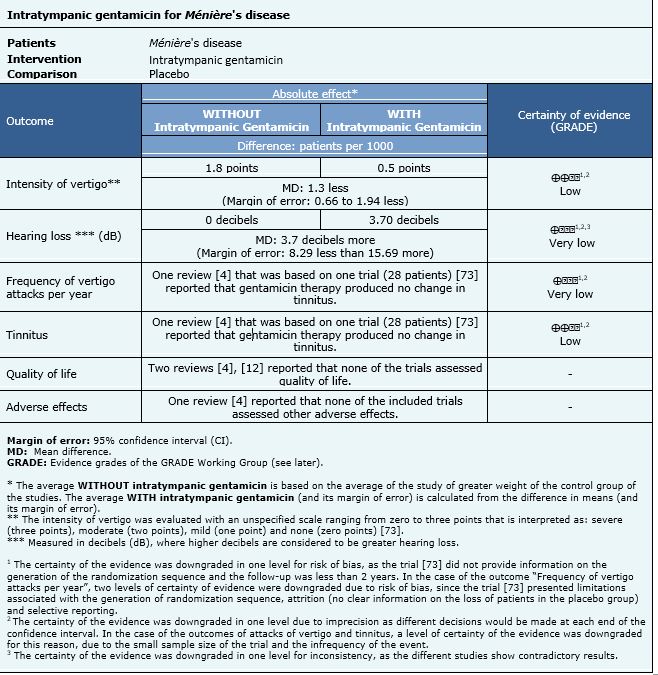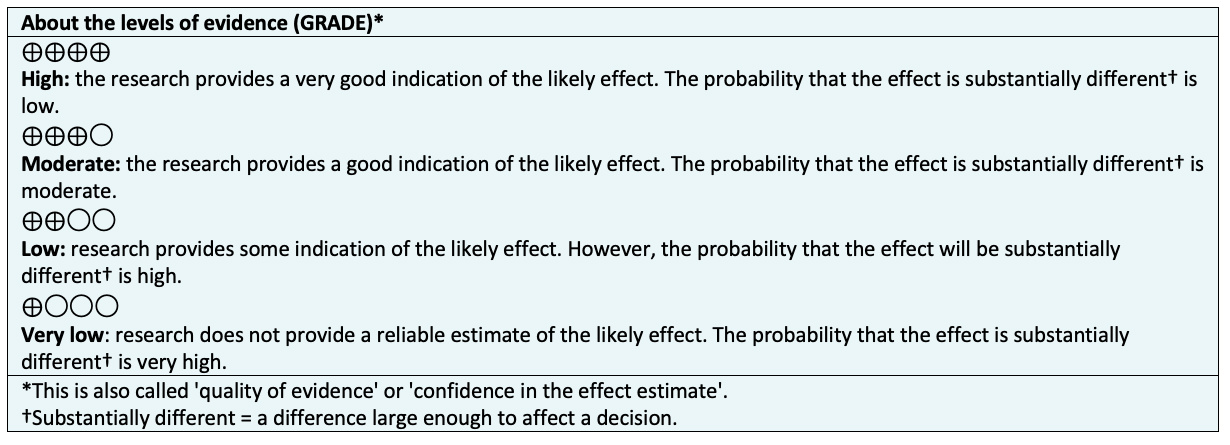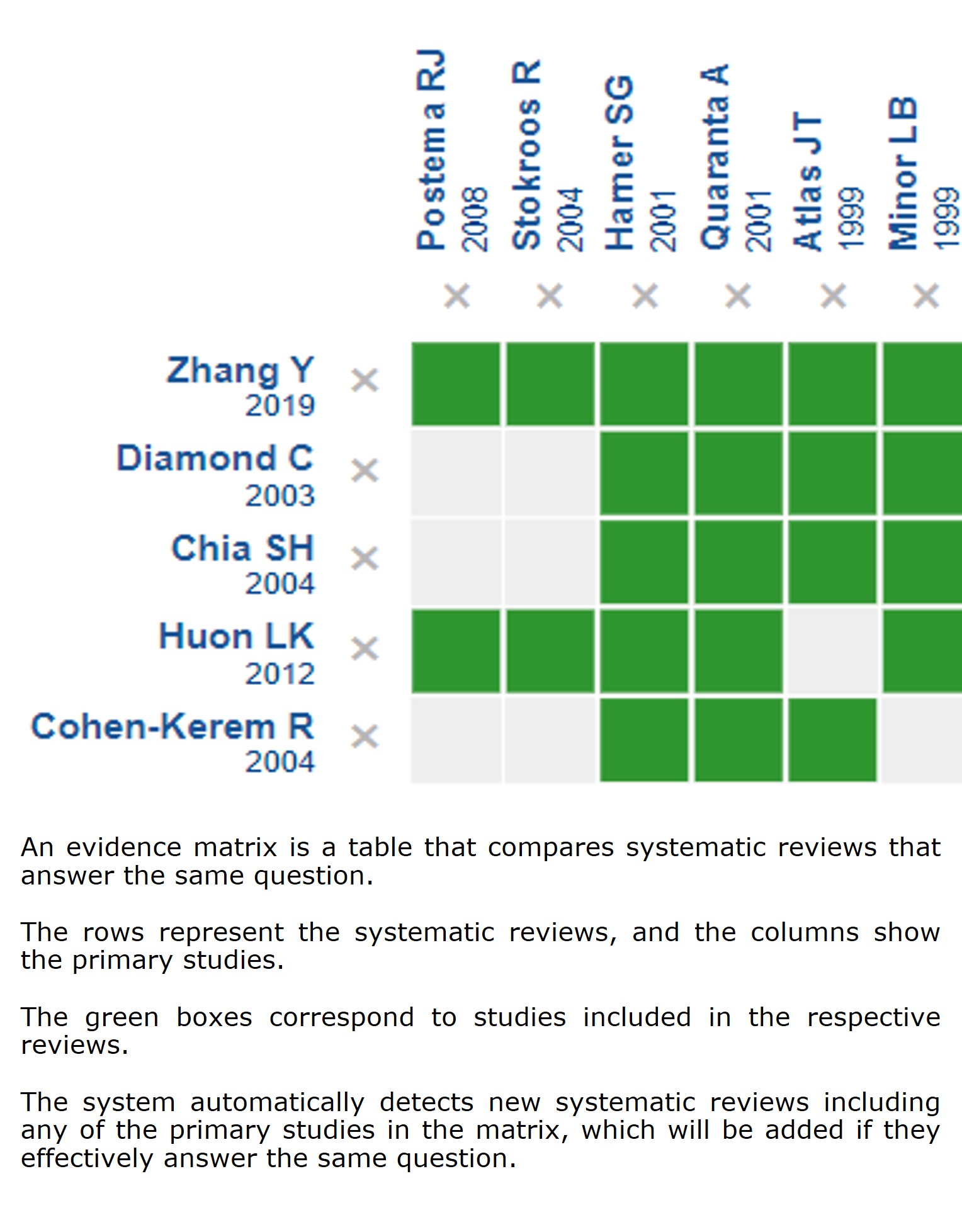Resúmenes Epistemonikos
← vista completaPublicado el 22 de marzo de 2022 | http://doi.org/10.5867/medwave.2022.02.8695
Gentamicina intratimpánica comparado con placebo para la enfermedad de Ménière
Intratympanic gentamicin compared with placebo for Ménière's disease
Abstract
INTRODUCTION Ménière's disease is a multifactorial disorder affecting the inner ear, characterized by episodes of spontaneous and recurrent vertigo, fluctuating hearing loss and tinnitus. Intratympanic gentamicin therapy has been used to reduce the intensity and frequency of attacks in intractable Ménière's disease, but it is associated with hearing loss. There is controversy regarding its efficacy and safety.
METHODS We searched in Epistemonikos, the largest database of systematic reviews in health, which is maintained by screening multiple information sources, including MEDLINE, EMBASE, Cochrane, among others. We extracted data from the systematic reviews, reanalyzed data of primary studies, conducted a meta-analysis and generated a summary of findings table using the GRADE approach.
RESULTS AND CONCLUSIONS We identified 13 systematic reviews that included 80 primary studies overall, of which three correspond to randomized trials. We concluded that intratympanic gentamicin may improve the control of vertigo, and result in little or no difference to tinnitus, but the certainty of the evidence is low. Furthermore, we are uncertain whether intratympanic gentamicin reduces hearing or the frequency of vertigo attacks as the certainty of the evidence has been assessed as very low.
Problem
Ménière's disease is a chronic, disabling and progressive illness, characterized by recurrent episodic spontaneous vertigo, hearing loss, aural fullness and tinnitus. The initial treatment consists of lifestyle modifications, including dietary sodium restriction, and medications such as diuretics and betahistine. However, it is estimated that 10% [1] of patients are refractory to the initial management, presenting at least one attack per month along with sensory hearing loss for six months or more [2]. Consequently, other more expensive and with a higher complication rate treatment alternatives, as surgical interventions, are considered.
Since there is no standard management for refractory Ménière's disease, multiple alternatives have been proposed, including the use of intratympanic aminoglycosides, specifically gentamicin, considered a minimally invasive therapy. Gentamicin acts at the inner ear level, producing partial or total ablation of the vestibular organ, mainly in vestibular hair cells, resulting in control of vertigo with less damage to the cochlear function [1]. However, there is no consensus on the protocol for intratympanic administration of gentamicin, nor clarity regarding its effectiveness and safety.
Methods
We searched in Epistemonikos, the largest database of systematic reviews in health, which is maintained by screening multiple information sources, including MEDLINE, EMBASE, Cochrane, among others, to identify systematic reviews and their included primary studies. We extracted data from the identified reviews and reanalyzed data from primary studies included in those reviews. With this information, we generated a structured summary denominated FRISBEE (Friendly Summary of Body of Evidence using Epistemonikos) using a pre-established format, which includes key messages, a summary of the body of evidence (presented as an evidence matrix in Epistemonikos), meta-analysis of the total of studies when it is possible, a summary of findings table following the GRADE approach and a table of other considerations for decision-making.
|
Key messages
|
About the body of evidence for this question
|
What is the evidence. |
We found 13 systematic reviews [3], [4], [5], [6], [7], [8], [9], [10], [11], [12], [13], [14 ], [15], that included 80 primary studies [16], [17], [18], [19], [20], [21], [22], [23], [24], [25], [26], [27], [28], [29], [30], [31], [32], [33], [34], [35], [36], [37], [38 ], [39], [40], [41], [42], [43], [44], [45], [46], [47], [48], [49], [50], [51], [52], [53], [54], [55], [56], [57], [58], [59], [60], [61], [62], [63 ], [64], [65], [66], [67], [68], [69], [70], [71], [72], [73], [74], [75], [76], [77], [78], [79], [80], [81], [82], [83], [84], [85], [86], [87], [88 ], [89], [90], [91], [92], [93], [94], [95], three of which correspond to randomized trials [23], [73], [87].This table and the summary in general are based on the randomized trials, as the observational studies did not increase the level of certainty of the evidence, nor added any additional relevant information. |
|
What type of patients did the studies include? * |
The diagnostic criteria used in the three trials [23], [73], [87], was obtained from a 1995 clinical guideline of the American Academy of Otolaryngology-Head and Neck Surgery (AAO-HNS) for the diagnosis of unilateral Ménière's disease. Two trials selected patients without previous surgical intervention [73], [87] and all of them included patients refractory to conservative management, defined as failure after six months [23], [87] or failure after treatment with betahistine [73] .One of the trials [73] included patients who presented a positive caloric response measured by electronystagmography. |
|
What type of interventions did the studies include? * |
Two of the trials used intratympanic gentamicin at 30 mg/ml with a weekly titration protocol [73], [87]. One trial used a dose of 0.4 ml [73] and the other one used four ml [87]. One of them installed a ventilation tube in the tympanic membrane four weeks prior to the start of treatment where gentamicin was injected [73], unlike the other trial that used tympanic puncture [87]. The remaining trial [23] used gentamicin at 40 mg/ml weekly without defining the volume. The cumulative dose differed between one [87] to four [23], [73]. All trials compared against placebo. One trial injected four ml of a buffer solution [87], another trial used 0.4 ml weekly for four weeks [73]. The remaining trial used 0.9% NaCl without specifying dose [23]. |
|
What type of outcomes did they measure |
The trials evaluated multiple outcomes, which were grouped by the systematic reviews as follows:
The average follow-up of the studies was 17.7 months with a range between 6 and 28 months [23], [73], [87]. |
*Information on primary studies is extracted from the identified systematic reviews, not directly from the studies unless otherwise specified.
Summary of results
The information on the effects of intratympanic gentamicin for intractable Ménière's disease is based on three randomized trials that included 60 patients [23], [73],[87].
One trial reported reduction of vertigo intensity (28 patients) [73] and three reported hearing loss (60 patients) [23], [73], [87]. No review allowed the extraction of data on vertigo attacks per year and tinnitus, therefore the information on these is presented as a narrative synthesis. None of the trials reported quality of life and adverse effects.
The summary of the results is as follows:
- The use of intratympanic gentamicin may reduce intensity of vertigo (the certainty of the evidence is low).
- We are uncertain whether intratympanic gentamicin reduces hearing because the certainty of the evidence has been assessed as very low.
- We are uncertain whether intratympanic gentamicin reduces the frequency of attacks of vertigo per year, because the certainty of the evidence has been assessed as very low.
- Intratympanic gentamicin use may result in little or no difference in tinnitus (the certainty of the evidence is low).
- No studies were found that evaluated the quality of life outcome.
- No studies were found that evaluated the outcome of adverse effects.

Follow the link to access the interactive version of this table (Interactive Summary of Findings - iSoF)

Other considerations for decision-making
| To whom this evidence applies and to whom it does not apply. |
|
|
About the outcomes included in this summary |
|
|
Balance between benefits and risks, and certainty of the evidence |
|
|
Resource considerations |
|
|
What would patients and their doctors think about this intervention |
|
|
Differences between this summary and other sources |
|
|
Could this information change in the future? |
|
How we conducted this summary
We collected all the relevant evidence for this question and presented it in an evidence matrix using automated and collaborative methods.

Follow the link to access the interactive version: Gentamicin versus placebo or not treatment in Meniere´s disease
Notes
If new systematic reviews on this topic are published after the publication of this abstract, a "new evidence" notification will be displayed at the top of the matrix. While the project provides regular updates of these abstracts, users are invited to comment on the Medwave website or contact the authors by e-mail if they believe evidence warrants an earlier update.
After creating an Epistemonikos account, by saving the matrices, you will receive automatic notifications whenever there is new evidence that potentially answers this question.
This article is part of the Epistemonikos evidence synthesis project. It is elaborated with a pre-established methodology, following rigorous methodological standards and an internal peer review process. Each of these articles corresponds to a summary, called FRISBEE (Friendly Summary of Body of Evidence using Epistemonikos), whose main objective is to synthesize the body of evidence of a specific question, in a friendly manner for physicians. The main resources are based on the Epistemonikos evidence matrix and the analysis of the result is based on the GRADE methodology. Further details of this FRISBEE elaboration method are described here.
The Epistemonikos Foundation is an organization that seeks to bring information closer to health decision-makers through the use of technologies. Its main source is the Epistemonikos database (www.epistemonikos.org).
Competing interest
The authors declare no competing interest.

